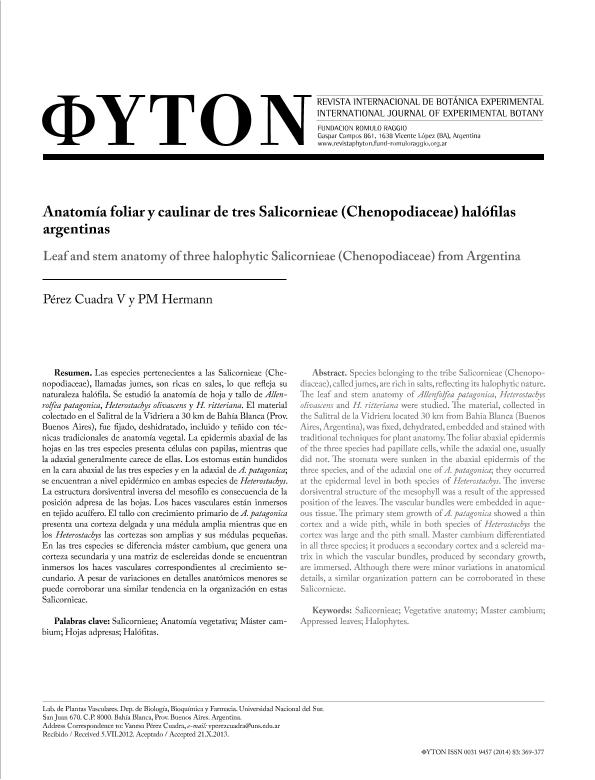Artículo
Las especies pertenecientes a las Salicornieae (Chenopodiaceae), llamadas jumes, son ricas en sales, lo que refleja su naturaleza halófila. Se estudió la anatomía de hoja y tallo de Allenrolfea patagonica, Heterostachys olivascens y H. ritteriana. El material colectado en el Salitral de la Vidriera a 30 km de Bahía Blanca (Prov. Buenos Aires), fue fijado, deshidratado, incluido y teñido con técnicas tradicionales de anatomía vegetal. La epidermis abaxial de las hojas en las tres especies presenta células con papilas, mientras que la adaxial, generalmente carece de ellas. Los estomas están hundidos en la cara abaxial de las tres especies y en la adaxial de A. patagonica; se encuentran a nivel epidérmico en ambas especies de Heterostachys. La estructura dorsiventral inversa del mesofilo es consecuencia de la posición adpresa de las hojas. Los haces vasculares están inmersos en tejido acuífero. El tallo con crecimiento primario de A. patagonica presenta una corteza delgada y una médula amplia mientras que en los Heterostachys las cortezas son amplias y sus médulas pequeñas. En las tres especies se diferencia máster cambium, que genera una corteza secundaria y una matriz de esclereidas donde se encuentran inmersos los haces vasculares correspondientes al crecimiento secundario. A pesar de variaciones en detalles anatómicos menores se puede corroborar una similar tendencia en la organización en estas Salicornieae. Species belonging to the tribe Salicornieae (Chenopodiaceae), called jumes, are rich in salts, reflecting its halophytic nature. The leaf and stem anatomy of Allenfolfea patagonica, Heterostachys olivascens and H. ritteriana were studied. The material, collected in the Salitral de la Vidriera located 30 km from Bahia Blanca (Buenos Aires, Argentina), was fixed, dehydrated, embedded and stained with traditional techniques for plant anatomy. The foliar abaxial epidermis of the three species had papillate cells, while the adaxial one, usually did not. The stomata were sunken in the abaxial epidermis of the three species, and of the adaxial one of A. patagonica; they occurred at the epidermal level in both species of Heterostachys. The inverse dorsiventral structure of the mesophyll was a result of the appressed position of the leaves. The vascular bundles were embedded in aqueous tissue. The primary stem growth of A. patagonica showed a thin cortex and a wide pith, while in both species of Heterostachys the cortex was large and the pith small. Master cambium diferentiated in all three species; it produces a secondary cortex and a sclereid matrix in which the vascular bundles, produced by secondary growth, are immersed. Although there were minor variations in anatomical details, a similar organization pattern can be corroborated in these Salicornieae.
Anatomía foliar y caulinar de tres Salicornieae (Chenopodiaceae) halófilas argentinas
Título:
Leaf and stem anatomy of three halophytic Salicornieae (Chenopodiaceae) from Argentina
Fecha de publicación:
12/2014
Editorial:
Fundacion Romulo Raggio
Revista:
Phyton - International Journal of Experimental Botany
ISSN:
0031-9457
Idioma:
Español
Tipo de recurso:
Artículo publicado
Clasificación temática:
Resumen
Palabras clave:
Salicornieae
,
Anatomía Vegetativa
,
Master Cámbium
,
Halófitas
,
Hojas Adpresas
Archivos asociados
Licencia
Identificadores
Colecciones
Articulos(CCT - BAHIA BLANCA)
Articulos de CTRO.CIENTIFICO TECNOL.CONICET - BAHIA BLANCA
Articulos de CTRO.CIENTIFICO TECNOL.CONICET - BAHIA BLANCA
Articulos(INBIOSUR)
Articulos de INSTITUTO DE CIENCIAS BIOLOGICAS Y BIOMEDICAS DEL SUR
Articulos de INSTITUTO DE CIENCIAS BIOLOGICAS Y BIOMEDICAS DEL SUR
Articulos(IQUIMEFA)
Articulos de INST.QUIMICA Y METABOLISMO DEL FARMACO (I)
Articulos de INST.QUIMICA Y METABOLISMO DEL FARMACO (I)
Citación
Pérez Cuadra, Vanesa; Hermann, Romina; Anatomía foliar y caulinar de tres Salicornieae (Chenopodiaceae) halófilas argentinas; Fundacion Romulo Raggio; Phyton - International Journal of Experimental Botany; 83; 2; 12-2014; 369-377
Compartir




